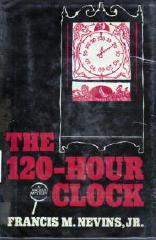Sat 15 Aug 2009
Reviewed by Marvin Lachman: FRANCIS M. NEVINS, JR. – The 120-Hour Clock.
Posted by Steve under Reviews[2] Comments
by Marvin Lachman
FRANCIS M. NEVINS, JR. – The 120-Hour Clock.
Walker, hardcover, 1986. Paperback reprints: Penguin, 1987; iUniverse, 2000.

One of the last mysteries published in 1986, The 120-Hour Clock by Francis M. Nevins, Jr., turned out to be one of the most enjoyable. Nevins has abandoned (except for a cameo appearance) his previous series sleuth, Loren Mensing, in favor of an extraordinary con man, Milo Turner, whose life and happiness depend upon his solving a murder.
The first chapter is an absolute grabber, beginning with a paragraph from Turner’s notebook in which he sounds the way Cornell Woolrich might have if he were reflecting on his career as a con man, instead of as a writer. After that we ride the Milonic roller coaster, mostly through New York and St. Louis, a world which includes Schultz’s Human Supermarket and Lafferty’s Identity Bazaar. .
Nevins operates on two levels. First, his book is a big-caper novel and practically a treatise on the scam, though its pace is far from scholarly. Using verbs the way Nevins does (purists may blanch), I can say I page-turned compulsively. Yet Nevins evokes considerable poignancy from his character, and, incidentally, he writes excellent love scenes, several with a nicely erotic touch.
If you’ve heard that Walker only publishes “cozy” books, disenchant yourself of that notion. The sex and the language are strong here, but they are appropriate; nothing is gratuitous.
The mystery reader of the future, say in the twenty-second century, can learn a great deal about how we lived in the latter half of this century from The 120-Hour Clock. There are scenes in large motels that perfectly capture how it is to spend time there.
In another scene, Turner and a woman he loves walk through Manhattan: “I linked my arm in hers as we trod the empty streets, talking in whispers so we wouldn’t wake the bag people sleeping on the steam vents.”
I’m not sure I believe all of this book, especially the ease with which Turner establishes new identities. I’m not ever sure I was supposed to. After all, Nevins is really in the same field as Turner, who says he’s “in the business of giving apparent reality to what doesn’t exist.” Both are highly successful at their professions.
August 16th, 2009 at 6:29 am
Clearly I’m going to have to find this one. I’m a sucker for the great rogues anyway, and this sounds like one I shouldn’t let slip away.
August 16th, 2009 at 1:50 pm
Milo Turner is also in The Ninety Million Dollar Mouse (Walker, 1987), but unless he showed up in a short story or two, these are his only two appearances.
[…]
Added later:
Bagworms. Novelette: EQMM Oct 6 1980.